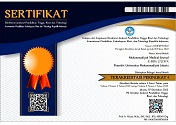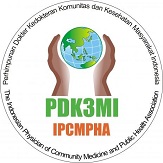Uncovering the Enolase Gene (eno) and Its Role in Biofilm Formation in Clinical Isolates of Staphylococcus aureus
Abstract
Background: Enolase is an enzyme potentially possessed by Staphylococcus aureus (S.aureus) bacteria, which holds essential virulence factors in human infections. The eno gene that encodes enolase is important in attachment to host cells, leading to biofilm formation, evasion of host immune response, and bacterial central metabolism. This biofilm formation might complicate the therapy. Purposes: This study aimed to assess the prevalence of the enolase gene, namely eno, in clinical isolates of S.aureus and its association with biofilm production. Methods: The research was conducted from December 1, 2023, to February 29, 2024, at the Faculty of Medicine and Health Science Research Laboratory, Warmadewa University. This study employed an analytical approach with a cross-sectional design. Result: The collected samples comprised 18 isolates of S.aureus, 66.6% of which produced biofilm. Most of the S.aureus clinical isolates 17 (94.4%) were detected to have the eno gene. Six samples (33.3%) formed weak biofilm followed by strong and moderate, with the same number of 3 isolates each (16.7%). No correlation between the enolase gene and biofilm production in this study suggested phenotypic heterogeneity, environment and time forming biofilm in vivo differences, and various other genes that influence biofilm formation. Conclusion: The high prevalence of the enolase gene in these clinical isolates indicates the potential for more severe infections in patients related to its adherence, which leads to biofilm and resistance problems and metabolic function.
Keywords
Full Text:
PDFReferences
Hemmadi V, Biswas M. An overview of moonlighting proteins in Staphylococcus aureus infection. Vol. 203, Archives of Microbiology. Springer Science and Business Media Deutschland GmbH; 2021. p. 481–98.
Wu X, Wang Y, Tao L. Sulfhydryl compounds reduce Staphylococcus aureus biofilm formation by inhibiting PIA biosynthesis. Vol. 316, FEMS Microbiology Letters. 2011. p. 44–50.
El-Saeed Mashaly G, Badr D. Adhesins Encoding Genes and Biofilm formation as Virulence Determinants in Methicillin Resistant Staphylococcus aureus Causing Hospital Acquired Infections. Vol. 31, Egyptian Journal of Medical Microbiology. 2022.
Nourbakhsh F, Ebrahimzadeh Namvar A. Detection of genes involved in biofilm formation in Staphylococcus aureus isolates. GMS Hyg Infect Control. 2016;11:1–5.
Mir Z, Farahani NN, Abbasian S, Alinejad F, Sattarzadeh M, Pouriran R, et al. The prevalence of exotoxins, adhesion, and biofilm-related genes in Staphylococcus aureus isolates from the main burn center of Tehran, Iran. Iran J Basic Med Sci. 2019;22(11):1267–74.
El-Saeed Mashaly G, Badr D. Adhesins Encoding Genes and Biofilm formation as Virulence Determinants in Methicillin Resistant Staphylococcus aureus Causing Hospital Acquired Infections. Vol. 31, Egyptian Journal of Medical Microbiology. 2022.
Águila-arcos S, Álvarez-rodríguez I, Garaiyurrebaso O. Biofilm-Forming Clinical Staphylococcus Isolates Harbor Horizontal Transfer and Antibiotic Resistance Genes. 2018;8(October 2017):1–12.
York N, San C, Athens F, Madrid L, City M, Riedel S, et al. Jawetz, Melnick, & Adelberg’s Medical Microbiology, Twenty-Eighth Edition [Internet]. 28th ed. McGraw-Hill; 2019. Available from: www.mhprofessional.com.
Mahon MS CR, Lehman EdD MLScm SM DC. Textbook of Diagnostic Microbiology, Sixth Edition. Textbook of Diagnostic Microbiology. 2019.
Tong SYC, Davis JS, Eichenberger E, Holland TL, Fowler VG. Staphylococcus aureus infections: Epidemiology, pathophysiology, clinical manifestations, and management. Clin Microbiol Rev. 2015;28(3):603–61.
Yu W, Kim HK, Rauch S, Schneewind O, Missiakas D. Pathogenic conversion of coagulase-negative staphylococci. Microbes Infect. 2017 Feb 1;19(2):101–9.
de Oliveira A, Pinheiro-Hubinger L, Pereira VC, Riboli DFM, Martins KB, Romero LC, et al. Staphylococcal biofilm on the surface of catheters: Electron microscopy evaluation of the inhibition of biofilm growth by rnaiii inhibiting peptide. Antibiotics. 2021 Jul 1;10(7).
Neopane P, Nepal HP, Shrestha R, Uehara O, Abiko Y. In vitro biofilm formation by Staphylococcus aureus isolated from wounds of hospital-admitted patients and their association with antimicrobial resistance. Int J Gen Med. 2018;11:25–32.
Avila-Novoa MG, Iñíguez-Moreno M, Solís-Velázquez OA, González-Gómez JP, Guerrero-Medina PJ, Gutiérrez-Lomelí M. Biofilm Formation by Staphylococcus aureus Isolated from Food Contact Surfaces in the Dairy Industry of Jalisco, Mexico. J Food Qual. 2018;2018.
Goel N, Fatima SW, Kumar S, Sinha R, Khare SK. Antimicrobial resistance in biofilms: Exploring marine actinobacteria as a potential source of antibiotics and biofilm inhibitors. Vol. 30, Biotechnology Reports. Elsevier B.V.; 2021.
Rasamiravaka T, Labtani Q, Duez P, El Jaziri M. The formation of biofilms by pseudomonas aeruginosa: A review of the natural and synthetic compounds interfering with control mechanisms. Vol. 2015, BioMed Research International. Hindawi Limited; 2015.
Setiabudy M, I Ketut Agus Indra Adhiputra, Agus Eka Darwinata, Ni Nengah Dwi Fatmawati. Correlation Between icaA/B/C/D Gene and Biofilm Formation in Staphylococcus aureus Infection. Jurnal Kedokteran. 2023 Dec 25;9(1):15–22.
Marta Setiabudy, Dewa Ayu Putri Sri Masyeni, Anak Agung Gede Indraningrat, Kadek Suryawan, I Ketut Agus Indra Adhiputra, Muhammad Amirul bin Abdul Rahman. Biofilm Formation in Staphylococcus aureus and Coagulase-Negative Staphylococcus. Folia Medica Indonesiana. 2023 Sep 10;59(3):222–8.
Humaryanto, Hanina. Comparison of Three Method of DNA Extraction For Methicillin Resistant Staphylococcus Aureus (MRSA).
Mirzaee M, Peerayeh SN, Ghasemian AM. Detection of icaABCD Genes and Biofilm Formation in Clinical Isolates of Methicillin Resistant Staphylococcus aureus. Vol. 9, Iranian Journal of Pathology. 2014.
Haghi Ghahremanloi Olia A, Ghahremani M, Ahmadi A, Sharifi Y. Comparison of biofilm production and virulence gene distribution among community- and hospital-acquired Staphylococcus aureus isolates from northwestern Iran. Infection, Genetics and Evolution. 2020 Jul 1;81.
Linz MS, Mattappallil A, Finkel D, Parker D. Clinical Impact of Staphylococcus aureus Skin and Soft Tissue Infections. Vol. 12, Antibiotics. MDPI; 2023.
Howden BP, Giulieri SG, Wong Fok Lung T, Baines SL, Sharkey LK, Lee JYH, et al. Staphylococcus aureus host interactions and adaptation. Vol. 21, Nature Reviews Microbiology. Nature Research; 2023. p. 380–95.
Turbawaty DK, Logito V, Tjandrawati A. Methicillin-Resistant Staphylococcus aureus (MRSA) Patterns and Antibiotic Susceptibility in Surgical and Non-Surgical Patients in a Tertiary Hospital in Indonesia. Majalah Kedokteran Bandung [Internet]. 2021 Sep;53(3):148–54. Available from: http://journal.fk.unpad.ac.id/index.php/mkb/article/view/2396
Omidi M, Firoozeh F, Saffari M, Sedaghat H, Zibaei M, Khaledi A. Ability of biofilm production and molecular analysis of spa and ica genes among clinical isolates of methicillin-resistant Staphylococcus aureus. BMC Res Notes. 2020 Jan 7;13(1).
Harika K, Shenoy V, Narasimhaswamy N, Chawla K. Detection of biofilm production and its impact on antibiotic resistance profile of bacterial isolates from chronic wound infections. J Glob Infect Dis. 2020 Jul 1;12(3):129–34.
Piechota M, Kot B, Frankowska-Maciejewska A, Gruzewska A, Woźniak-Kosek A. Biofilm Formation by Methicillin-Resistant and Methicillin-Sensitive Staphylococcus aureus Strains from Hospitalized Patients in Poland. Biomed Res Int. 2018;2018.
Omar A, Wright JB, Schultz G, Burrell R, Nadworny P. Microbial biofilms and chronic wounds. Vol. 5, Microorganisms. MDPI AG; 2017.
Gajewska J, Chajęcka-Wierzchowska W. Biofilm formation ability and presence of adhesion genes among coagulase-negative and coagulase-positive staphylococci isolates from raw cow’s milk. Pathogens. 2020 Aug 1;9(8):1–12.
Kot B, Sytykiewicz H, Sprawka I. Expression of the biofilm-associated genes in methicillin-resistant Staphylococcus aureus in biofilm and planktonic conditions. Int J Mol Sci. 2018 Nov 6;19(11).
DOI: https://doi.org/10.24853/mmj.5.2.97-106
Refbacks
- There are currently no refbacks.
Indexed by:
Work is distributed under the Creative Commons Attribution-NonCommercial 4.0 International License.
Copyright of Muhammadiyah Medical Journal (e issn: 2721-317X)













13.jpg)
